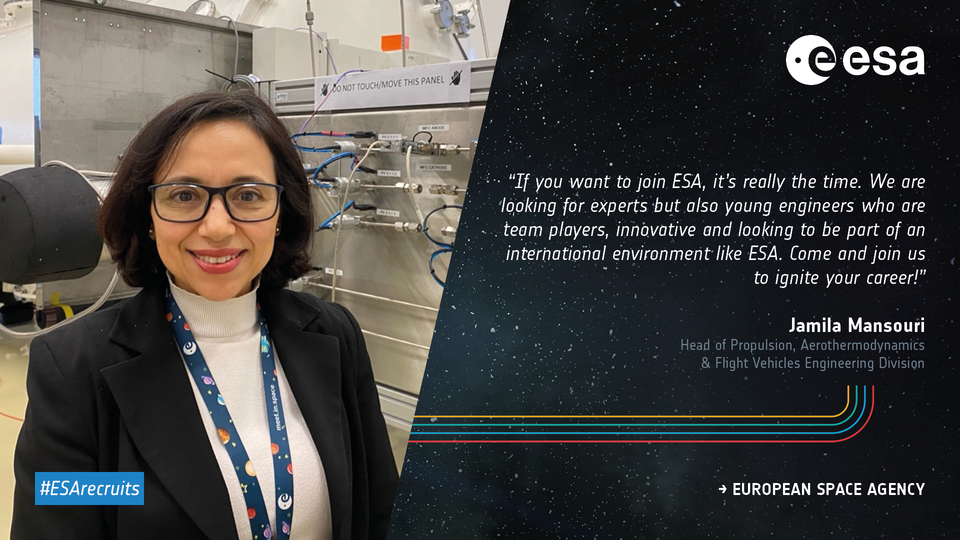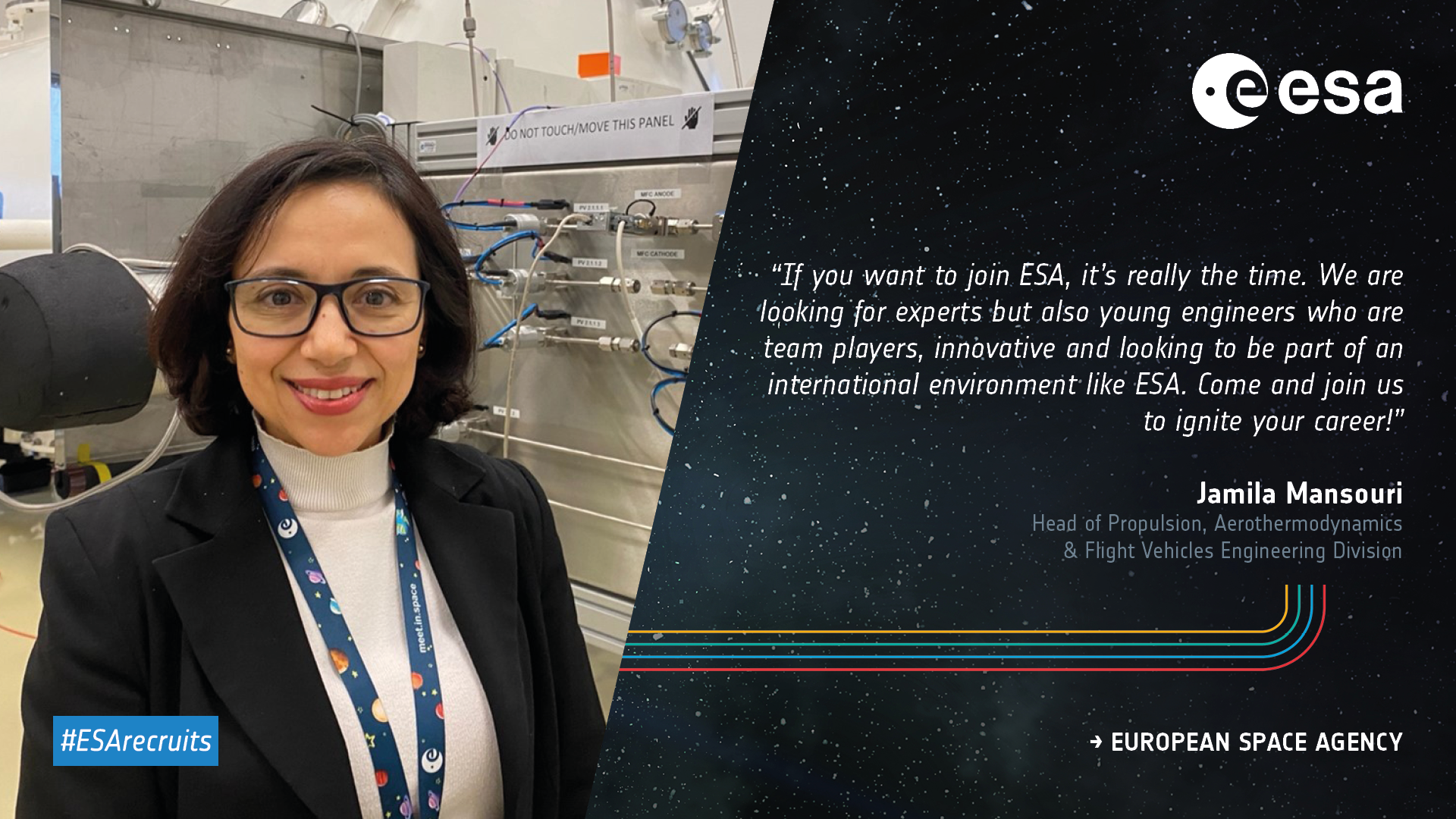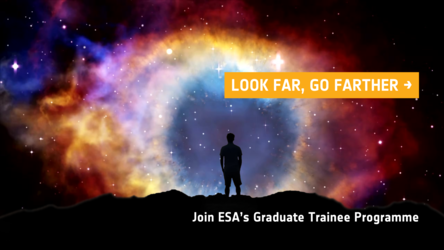Get to know ESA's Propulsion team
Hear from the team working closely on perfecting Newton’s third law of motion for some of ESA’s biggest projects and learn how engineers with diverse backgrounds work together to get missions into space! Here to introduce the Propulsion team and the work they do, we have Jamila Mansouri, Head of Propulsion, Aerothermodynamics and Flight Vehicles Engineering Division.

What are some of the biggest R&D projects your division has worked on?
In the Propulsion, Aerothermodynamics and Flight Vehicle Engineering Division, R&D projects are essential for giving the necessary impulsion for the technologies required by the missions and to support the validation of the missions.
Among the biggest R&D Projects:
- Electric Propulsion Innovative and Competitiveness Project (EPIC): Together with the European Commission, the ESA Electric Propulsion team coordinated the industrial teams and provided expertise in order to accelerate various electric propulsion technologies.
- MicroHetsat Project by SITAEL: The ESA Electric Propulsion team supported the development of the μHETSat propulsion system with Hall effect thrusters as part of the ESA General Support Technology Programme (GSTP)'s In Orbit Demonstration Element. The contribution of ESA experts included the μHETSat commissioning phase, which was successfully completed in January 2024.
- European Space Propulsion Simulation Toolkit (ESPSS) by EcosimPro: The mission of the ESA Aerothermodynamics and Flight Vehicles engineering team is to develop Fluid Mechanics technologies and multidisciplinary simulation/validation tools. Thanks to the team, ESPSS is now used by the Propulsion and Space Transportation communities for developing their products. More and more start-ups are benefiting from tools such as these to enable a rapid release to market.
- Space Rider Observatory Cube (SROC) by Tyvak: Together with the ESA System Engineering team, ESA Aerothermodynamics and Flight Vehicles experts contribute to SROC's development, a demonstrator at the crossroads of multiple disciplines. The SROC will be on board the first flight of Space Rider and will ensure an inspection of Space Rider before it returns to Earth.
- Synergetic Air Breathing Rocket Engine (SABRE) by Reaction Engines Ltd: The ESA Chemical Propulsion team is managing this R&D project based on a hybrid jet and rocket engine that will pave the way for future spaceplanes.
What missions are you and your team currently working on and what are some of the biggest challenges you are facing?
With Euclid and LISA, the main challenges are linked to micropropulsion. For Bepicolombo, which is currently on its way to Mercury, it is the new generation of electric propulsion ion thrusters that poses the biggest challenge. With Argonaut and Rosalind Franklin, we are focusing a lot on entry, descent and landing capabilities on the Moon or Mars. And for Ariane 6 and Astris kick stage, we have the challenges of a versatile launch service with reignition of cryogenic upper stage and complemented with a kick stage for the long-term missions.
What are the expected future projects and what kinds of backgrounds are you looking to join your division?
Our division has elaborated the Innovative Propulsion Cross Cutting Initiative with the main goal of boosting the Technology Readiness Level (TRL) of breakthrough propulsion technologies to harness significant benefits in terms of mass, performance, cost and flexibility. 14 topics have been identified and distributed in three groups:
- higher performance technologies
- technologies expanding space logistic capabilities
- greener and lower-cost technologies
We are looking for candidates with backgrounds related to these 14 topics, who also have forward-thinking skills and a proactive approach.

Join the Propulsion team!
The Young Graduate Trainee opportunities are now open for applications, and there are three positions working in propulsion. This is your chance to blast off your career with the European Space Agency! Apply before 7 March.
Young Graduate Trainee in Propulsion Engineering
You will support laboratory activities related to the current fields of research in the European Propulsion Laboratory (EPL) working in transient system aspects, such as priming peak assessments, water electrolysis propulsion and cubeSat chemical propulsion. Read more and apply here.
Young Graduate Trainee in Propulsion System Engineering for Argonaut
You will support the Argonaut Propulsion Lead in the development of the Argonaut Lander Descent Element (LDE) propulsion system for Europe’s first lunar lander. The propulsion system is a key sub-system and will include Europe’s first throttleable main engine for landing applications. Your activities during the traineeship will focus on supporting the propulsion lead in ensuring that the propulsion system is developed within schedule constraints. Read more and apply here.
Young Graduate Trainee in New Space Propulsion Test Facility Management (FM) and the European Space Transportation HUB
You will be reporting to the Head of the Propulsion Test Facilities and Services of the European Space Transportation HUB to implement the actions derived from ESA strategy regarding New Space propulsion tests and support the development, by ESA and CNES, of the freshly created European Space Transportation HUB. Read more and apply here.















 Germany
Germany
 Austria
Austria
 Belgium
Belgium
 Denmark
Denmark
 Spain
Spain
 Estonia
Estonia
 Finland
Finland
 France
France
 Greece
Greece
 Hungary
Hungary
 Ireland
Ireland
 Italy
Italy
 Luxembourg
Luxembourg
 Norway
Norway
 The Netherlands
The Netherlands
 Poland
Poland
 Portugal
Portugal
 Czechia
Czechia
 Romania
Romania
 United Kingdom
United Kingdom
 Slovenia
Slovenia
 Sweden
Sweden
 Switzerland
Switzerland































